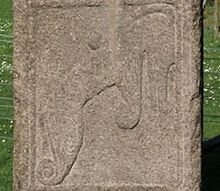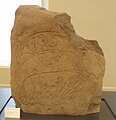| This article needs additional citations for verification. Please help improve this article by adding citations to reliable sources. Unsourced material may be challenged and removed. Find sources: "Pictish Beast" – news · newspapers · books · scholar · JSTOR (April 2015) (Learn how and when to remove this message) |


The Pictish Beast (sometimes Pictish Dragon or Pictish Elephant) is an artistic representation of an animal, distinct to the early medieval culture of the Picts of Scotland. The great majority of surviving examples are on Pictish stones.
The Pictish Beast accounts for about 40% of all Pictish animal depictions, and so was likely of great importance. The Pictish Beast is thought to have been an important figure in Pictish mythology, and possibly even a clan or political symbol.
Depiction on Stones
A comprehensive collection of depictions of the Pictish Beast was given by Stuart as Plate 22 in Sculptured Stones of Scotland Volume 2, 1867. Depictions are shown at a consistent scale and oriented as they were on the stones. The sequence in which they appear is described as
indicating their development from the outline form in which they first appear on the rude pillars, to that in which the outline is filled up with the ornamental devices of the cross-slabs

Design
The Pictish Beast is not easily identifiable with any real animal, but resembles a seahorse, especially when depicted upright. Suggestions have included a dolphin, an anteater, an elephant, a kelpie (or each uisge), and even the Loch Ness Monster. Chanonry Point and the Sutors of Cromarty lie close to the Pictish monasteries at Portmahomack and Rosemarkie and are recognised as some of the best sites in Britain for viewing bottlenose dolphins from the land.
Recent thinking is that the Pictish Beast might be related to the design of dragonesque brooches, which are S-shaped pieces of jewellery, made from the mid-1st to the 2nd century CE, that depict double-headed animals with swirled snouts and distinctive ears. A few of these have been found in Scotland, though the great majority have been found in northern England. The strongest evidence for this is the presence on the Mortlach 2 stone of a symbol very similar to such a brooch, next to and in the same alignment as a Pictish Beast.
See also
References
| This article includes a list of references, related reading, or external links, but its sources remain unclear because it lacks inline citations. Please help improve this article by introducing more precise citations. (June 2017) (Learn how and when to remove this message) |
- ^ Stuart, John (1867). Sculptured Stones of Scotland, Volume 2. Aberdeen: Spalding Club. pp. lxxvi, Plate 22.
Bibliography
- Jones, Duncan (2003). A Wee Guide to the Picts. Musselburgh.
- Cessford, Craig (June 2005). "Pictish art and the sea". The Heroic Age: A Journal of Medieval Northwestern Europe (8). ISSN 1526-1867.

